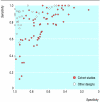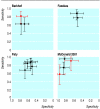Accuracy of magnetic resonance imaging for the diagnosis of multiple sclerosis: systematic review
- PMID: 16565096
- PMCID: PMC1479850
- DOI: 10.1136/bmj.38771.583796.7C
Accuracy of magnetic resonance imaging for the diagnosis of multiple sclerosis: systematic review
Abstract
Objective: To determine the accuracy of magnetic resonance imaging criteria for the early diagnosis of multiple sclerosis in patients with suspected disease.
Design: Systematic review.
Data sources: 12 electronic databases, citation searches, and reference lists of included studies. Review methods Studies on accuracy of diagnosis that compared magnetic resonance imaging, or diagnostic criteria incorporating such imaging, to a reference standard for the diagnosis of multiple sclerosis.
Results: 29 studies (18 cohort studies, 11 other designs) were included. On average, studies of other designs (mainly diagnostic case-control studies) produced higher estimated diagnostic odds ratios than did cohort studies. Among 15 studies of higher methodological quality (cohort design, clinical follow-up as reference standard), those with longer follow-up produced higher estimates of specificity and lower estimates of sensitivity. Only two such studies followed patients for more than 10 years. Even in the presence of many lesions (> 10 or > 8), magnetic resonance imaging could not accurately rule multiple sclerosis in (likelihood ratio of a positive test result 3.0 and 2.0, respectively). Similarly, the absence of lesions was of limited utility in ruling out a diagnosis of multiple sclerosis (likelihood ratio of a negative test result 0.1 and 0.5).
Conclusions: Many evaluations of the accuracy of magnetic resonance imaging for the early detection of multiple sclerosis have produced inflated estimates of test performance owing to methodological weaknesses. Use of magnetic resonance imaging to confirm multiple sclerosis on the basis of a single attack of neurological dysfunction may lead to over-diagnosis and over-treatment.
Figures








Comment in
-
Medical academia is failing patients and clinicians.BMJ. 2006 Apr 15;332(7546):863-4. doi: 10.1136/bmj.332.7546.863. BMJ. 2006. PMID: 16613937 Free PMC article. No abstract available.
-
Role of MRI in diagnosing multiple sclerosis: early diagnosis using MRI and early treatment delays disease conversion.BMJ. 2006 Apr 29;332(7548):1034-5. doi: 10.1136/bmj.332.7548.1034-b. BMJ. 2006. PMID: 16644840 Free PMC article. No abstract available.
-
Role of MRI in diagnosing multiple sclerosis: magnetic resonance imaging is valuable.BMJ. 2006 Apr 29;332(7548):1034. doi: 10.1136/bmj.332.7548.1034-a. BMJ. 2006. PMID: 16644841 Free PMC article. No abstract available.
-
Review: magnetic resonance imaging alone is of limited usefulness in diagnosing multiple sclerosis.ACP J Club. 2006 Sep-Oct;145(2):51. ACP J Club. 2006. PMID: 16944871 No abstract available.
-
Review: magnetic resonance imaging alone is of limited usefulness in diagnosing multiple sclerosis.Evid Based Med. 2006 Oct;11(5):155. doi: 10.1136/ebm.11.5.155. Evid Based Med. 2006. PMID: 17213157 No abstract available.
References
-
- Poser CM, Brinar VV. Diagnostic criteria for multiple sclerosis: an historical review. Clin Neurol Neurosurg 2004;106: 147-58. - PubMed
-
- Beck RW, Trobe JD, Moke PS, Gal RL, Xing D, Bhatti MT, et al. High- and low-risk profiles for the development of multiple sclerosis within 10 years after optic neuritis: experience of the optic neuritis treatment trial. Arch Ophthalmol 2003;121: 944-9. - PubMed
-
- Brex PA, Ciccarelli O, O'Riordan JI, Sailer M, Thompson AJ, Miller DH. A longitudinal study of abnormalities on MRI and disability from multiple sclerosis. New Engl J Med 2002;346: 158-64. - PubMed
-
- McDonald WI, Compston A, Edan G, Goodkin D, Hartung HP, Lublin FD, et al. Recommended diagnostic criteria for multiple sclerosis: guidelines from the international panel on the diagnosis of multiple sclerosis. Ann Neurol 2001;50: 121-7. - PubMed
-
- National Collaborating Centre for Chronic Conditions. Multiple sclerosis. National clinical guideline for diagnosis and management in primary and secondary care. London: Royal College of Physicians, 2004. - PubMed
Publication types
MeSH terms
Grants and funding
LinkOut - more resources
Full Text Sources
Other Literature Sources
Medical
Molecular Biology Databases
